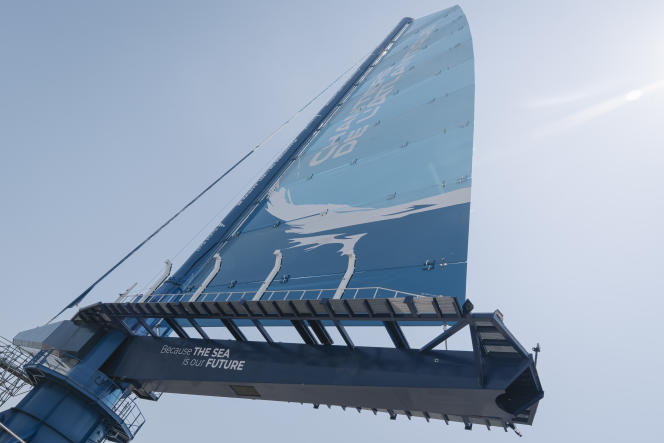On the port of Saint-Nazaire (Loire-Atlantique), sliding on its 75-meter-high mast, a rigid sail made of composite material rises to the sky, then descends again in a few minutes before tilting forward at 70 degrees. Once installed on a merchant ship or a cruise ship, Chantiers de l’Atlantique’s SolidSail will have to be able to pass under bridges, notes Nicolas Abiven, former skipper and project manager. A little further on, opposite the former submarine base, navigator Michel Desjoyeaux’s sailboat turns to windward, equipped with Michelin’s Wisamo inflatable sail, adorned with its smiling bibendum.
In the spans of the second Wind for Goods show, organized on 1er and June 2 by the Nantes Métropole Economic Development Agency, trimaran skipper François Gabart defends Vela, presented as “the most carbon-free alternative to conventional freight”. He wants to arm “100% high-performance cargo sailboats under sail” designed to connect Europe to the United States.
His eldest, Yves Parlier, details the merits of the kitesurfing wing of his company Beyond the Sea, based in the Arcachon basin: once passed from the 20 m prototype2 of surface to the industrial product of 200 m2it should enable large ships such as container ships to reduce their fuel consumption by 30% to 50%, and their greenhouse gas emissions accordingly.
Proliferation of technological solutions
The objective of all these projects – hybrid or, more rarely, exclusively sailing – is the same: to curb global warming and defend the biodiversity of the oceans. Maritime transport accounts for 90% of world trade. Although it is cleaner than air and road transport per “ton kilometre” transported, it represents 3% of global carbon emissions. A share that could rise to 17% in 2050 if it does nothing and other modes of transport advance, warns the International Maritime Organization (IMO), which depends on the United Nations. Sooner or later, shipowners will have to eliminate the heavy fuel oil burned by most of the 100,000 merchant ships cruising the seas of the globe.
For the time being, in the small world of cargo ships propelled by the wind, there is an abundance of technological solutions: flexible sail (textile), fiberglass or inflatable, flexible, semi-rigid or rigid wing, kitesurfing allowing increase traction in dynamic flight, rotor, metal wing with suction grid… They are supported by shipowners determined to decarbonize this mode of transport.
You have 75.63% of this article left to read. The following is for subscribers only.
